Are you looking to see incredible waterfalls, epic views, and enjoy stunning hikes? Consider exploring the southern coast of Maui on the incredible reverse Road to Hana Loop Drive. We loved driving around Maui and this is one drive you can’t miss. We strongly recommend doing this popular route in the opposite direction and making it into a loop. The Road to Hana reverse loop drive offers less crowds, more incredible views and more varied driving experience.
In this article you will find everything you need to know to plan you visit and drive on the Road to Hana. We’ll share the information you need to plan your trip, what to expect on the back side of Road to Hana loop, and the best stops to make the most of your day. We did this drive on our recent visit to Maui and were so glad we started the drive on the back Road to Hana before completing the official Road to Hana.
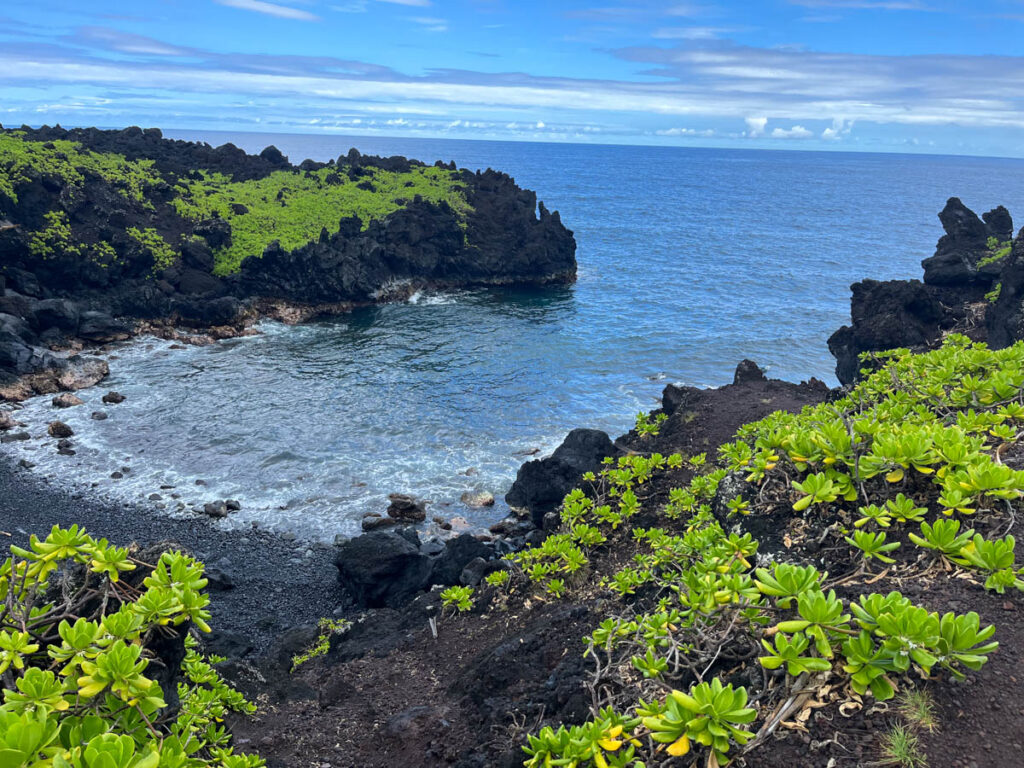
What is the Reverse Road to Hana?
The Road to Hana is a stretch of road along the northeastern coast of Maui. The scenic road has become an incredibly popular drive and one of the top things to do in Maui. Many people make a day of driving this windy road, stopping at waterfalls, beaches and hikes along the way. Spanning approximately 64 miles, The Road to Hana winds through lush rainforests, cascading waterfalls, and stunning coastal vistas. This iconic road is famous for its hairpin turns, narrow bridges, and numerous stops showcasing the island’s natural beauty.
To drive the Road to Hana, most people do the the trip as an out an back – driving to Hana or to Haleakala National Park and turning around to return the way you came. Instead of repeating part of the drive we suggest driving the road as a loop. The road along the southern coast of Maui travels through some of the most remote parts of the island and offers incredible views of the coastline. To avoid the crowds, the best way to do this is to drive the reverse Road to Hana loop.
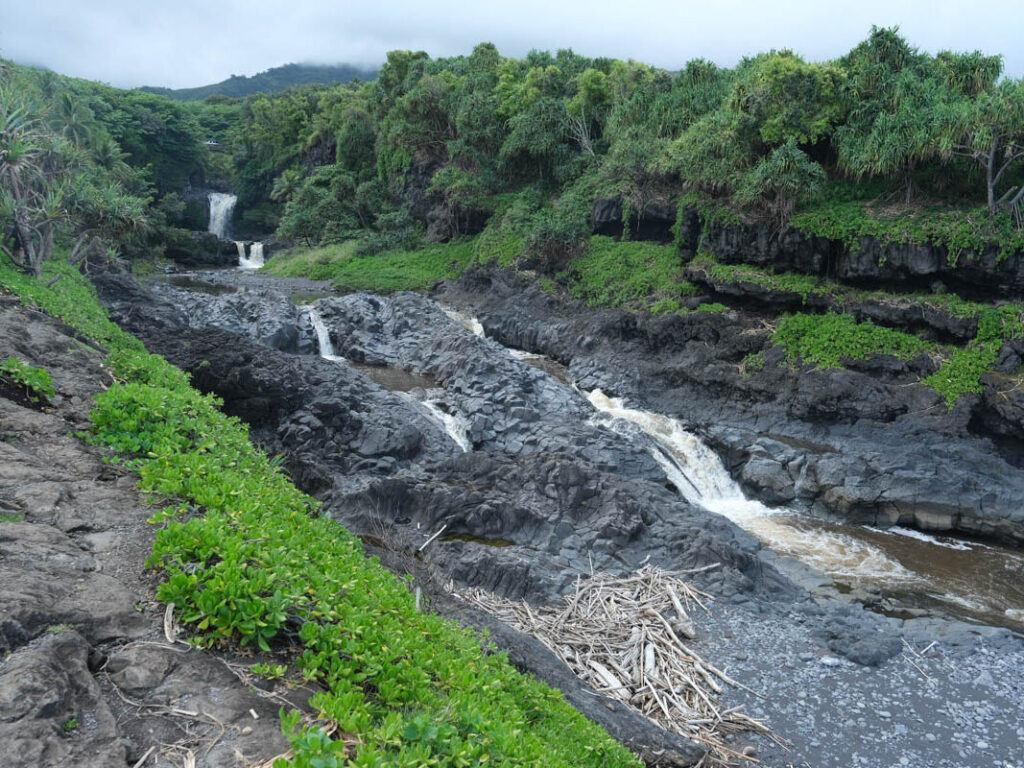
Here are the benefits of driving the reverse Road to Hana Loop:
- Reduced crowds and traffic congestion: By starting the journey in the reverse direction, you can avoid the peak traffic hours and enjoy a less crowded experience. This allows for a more relaxed and leisurely exploration of the attractions along the way. This works especially well if your most excited to hike the Pipiwai Trail.
- Unique perspective and different scenery: The reverse route provides a fresh perspective on the landscape, as you approach the sights from a different angle. You will also get to see the southern part of Maui which we truly loved.
- Access to less crowded attractions and hidden gems: Since most tourists follow the conventional route, opting for the reverse road opens up the opportunity to discover lesser-known attractions and hidden gems that are often bypassed. While the Road to Hana is windy, the road along the southern coast has a windy part and then the road opens up and is much easier to drive.
Planning and Preparation for Driving the Road to Hana Backwards
Choosing the right vehicle
When embarking on the reverse Road to Hana, selecting the appropriate vehicle is important. You do not need a 4×4 to do this drive as there are only a few areas of the road where it is not paved and all of these sections are in decent shape. On the entire Road to Hana backside, there are only about 2 miles of unpaved roads. Opt for a vehicle with good suspension and reliable brakes, as the road features numerous twists, turns, and uneven surfaces. It’s worth check with your rental car agency as there are some companies that restrict driving on certain parts of Maui.
Not interesting in driving yourself? You can also book a guided tour and enjoy a comfortable ride all day and suggestions for the best places to stop.

Road Conditions and Potential Challenges
While you don’t need a 4×4 to drive the Road to Hana or the reverse Road to Hana loop, it is helpful to be aware of challenges. adventure. Both the traditional Road to Hana and the Road to Hana backside of the loop have narrow sections (where only one car can pass at once), sharp curves, and one-lane bridges. Stay alert and exercise caution while driving, especially around blind corners. Keep an eye out for road signs indicating upcoming hazards or areas prone to landslides. Additionally, check the latest weather and road condition updates before embarking on the journey to ensure optimal safety. Note that there is limited cell service on the Road to Hana, so download maps and information and don’t count of being able to make calls along the route.

Fuel and Food Stops Along the Way
In the next section we’ll go over some of the best stops on the reverse Road to Hana loop but it’s important to be prepared for necessary stops. Much of the Road to Hana is remote so you should plan to start the drive with a full tank of gas. There are many places to stop and eat, but be prepared with some snacks.
Time Management and Pacing the Journey
Proper time management and pacing are key to fully enjoy the reverse Road to Hana experience and seeing everything Plan for an early start to make the most of the day and avoid rushing through the attractions. Allocate ample time for exploring each stop, taking in the beauty of waterfalls, hiking trails, and viewpoints. Be mindful of the daylight hours, as driving after dark can be challenging due to limited visibility. Creating a flexible itinerary allows for spontaneity and the ability to adapt to unexpected discoveries or extended stays at captivating locations. It will take about 2.5 hours to do the backside of the Road to Hana and get to Haleakala National Park.
Map of the Reverse Road to Hana
To use this map, click on the map and save it to your google account. You can then make your own changes and edits on the map.
Must-See Stops and Attractions on the Reverse Road to Hana
Below you can see a list of the best stops on the reverse Road to Hana. These are the top stops but you can find more places to visit along the route. Note that parking is challenging along the Road to Hana and limited. Follow posted signs and be respectful of locals and other drivers.
- Natural Sea Arch: Start your day by marveling at a breathtaking natural wonder. As you drive along this scenic country road, keep an eye out for a remarkable rock formation emerging from the ocean.
- Huakini Beach: Take a short stroll to the shoreline and prepare for a unique beach experience unlike any other on this tour. Instead of soft sand, you’ll find a beach adorned with an array of fascinating rocks
- View of Nu’u Bay & Haleakala: As you continue your journey, be sure to stop and take in the awe-inspiring view of Nu’u Bay and the majestic Haleakala volcano.
- Alelele Falls: To reach Alelele Falls, a short hike awaits, including a stream crossing. Fortunately, this waterfall is easily accessible and stands at an impressive height of approximately 50 feet and you can swim in the waterfall.
- Charles Lindbergh’s Grave: Venture to a secluded graveyard just before Haleakala, where you’ll find the solemn resting place of the renowned aviator, Charles Lindbergh. Lindbergh gained fame for his historic nonstop flight from New York to Paris.
- Kipahulu District – Explore the eastern side of Haleakala National Park, home to the enchanting Oheo Gulch and the captivating Seven Sacred Pools. Hike the Pipiwai Trail to see the bamboo forest.
- Wailua Falls – Witness the majestic 80-foot waterfall cascading down lush cliffs into a turquoise pool, creating a picturesque sight to behold. To get to Wailua Falls
- Upper Waikani Falls (Three Bears Falls) – Marvel at this trio of tiered waterfalls, affectionately known as the Three Bears Falls, framed by dense green foliage.
- Nahiku Marketplace – Discover a hidden gem nestled in the rainforest, offering an eclectic mix of local crafts, artisanal food, and live music in a serene setting.
- Keanae Peninsula – Visit this tranquil coastal village and enjoy panoramic views of the rugged lava coastline, ancient taro fields, and a picturesque stone church.
- Pua’a Ka’a State Wayside Park – Take a refreshing dip in the natural swimming pools or hike through the lush forest to discover enchanting waterfalls and scenic picnic spots.
- Waianapanapa State Park – Immerse yourself in the beauty of black sand beaches, sea caves, volcanic cliffs, and the mesmerizing Wai’anapanapa Cave. Reservations are required to visit this park (get a reservation).
- Honomanu Bay – Stop by this picturesque bay offering breathtaking views of dramatic cliffs, pristine coastline, and crashing waves, perfect for a serene moment of appreciation.
- Ke’anae Arboretum – Stroll through this tropical garden featuring an array of native Hawaiian plants, including vibrant flowers, exotic trees, and serene streams.
- Halfway to Hana – Pause at this roadside stand to savor delicious banana bread, fresh coconuts, and other local treats while enjoying scenic views of the coastline.
- Kaumahina State Wayside Park – Enjoy sweeping views of Maui’s northeastern coastline from this roadside park, complete with picnic tables and restrooms.
- Twin Falls – Trek through a bamboo forest to discover the stunning Twin Falls, a pair of picturesque waterfalls cascading into inviting pools.
- Ho’okipa Beach Park – Watch skilled surfers ride the waves, spot Hawaiian green sea turtles basking on the shore, and admire the scenic beauty of this popular beach.
- Haipua’ena Falls – Embark on a short hike through lush rainforest to witness the beauty of Haipua’ena Falls, a hidden gem cascading into a tranquil pool.
- Waikamoi Ridge Trail – Explore this scenic trail meandering through a dense rainforest, offering glimpses of vibrant flora, native birds, and panoramic vistas.
- Garden of Eden Arboretum – Discover a breathtaking botanical garden showcasing diverse plant species, tranquil waterfalls, and magnificent views of Maui’s north shore.
- Huelo Lookout – Enjoy sweeping views of the coastline, lush vegetation, and distant waterfalls from this scenic viewpoint along the Reverse Road to Hana.
- Pauwela Point – Admire panoramic ocean views, crashing waves, and, if you’re lucky, spot humpback whales during the winter months from this picturesque overlook.
- Kaumahina State Wayside Park – Pause at this scenic park offering picnic areas and lookout points with breathtaking views of the coastline and lush vegetation.
- Keanae Lookout – Stop at this vantage point to witness the stunning convergence of the lush taro fields and the jagged coastline.

There is absolutely no way you can see everything along this route. We recommend choosing your top 5 sites along the route and planning your day around these attractions. Then you can keep the list of other attractions on hand and make additional stops based on your timing. Just driving time around the reverse Road to Hana will take about 5-6 hours.
In our opinion, these are the top 5 attractions on the reverse Road to Hana. We also recommend stopping at one or more the local food stops:
- Wai’anapanapa State Park and the Coastal Trail
- Seven Sacred Pools (Ohe’o Gulch) and the Pipiwai Trail
- Waikamoi Ridge Trail
- Wailua Falls
- Ke’anae Peninsula
What to Bring when driving the Road to Hana in Reverse
When driving the Reverse Road to Hana, proper packing and preparation are essential for a smooth and enjoyable journey. Here are some packing essentials and travel tips to ensure you’re well-equipped for the adventure ahead.
A. Be sure to bring essential items such as a map or GPS, bug spray, a first aid kit, and a fully charged mobile phone for emergencies.
B. Dress comfortably and wear sturdy footwear suitable for walking and exploring diverse terrains. Don’t forget to protect yourself from the sun by packing sunscreen, hats, and sunglasses. If you plan to do some hiking, hiking boots or shoes are essential as many of the trail have sharp rocks and uneven surfaces. You should also consider a rain coat and bathing suit.
C. Stay nourished and hydrated by packing snacks, plenty of water, and other supplies like wet wipes, tissues, and a reusable water bottle. By considering these tips, you’ll be well-prepared to embark on your reverse Road to Hana journey and make the most of your unforgettable experience.

Common Questions about the Reverse Road to Hana
Is driving the Reverse Road to Hana more challenging than the traditional route?
While the Reverse Road to Hana may offer a different perspective and unique attractions, it is generally considered more challenging than the traditional route. The road is narrower, winding, and often unpaved, requiring cautious driving and potentially slower travel times. Additionally, the Reverse Road to Hana is less crowded and offers fewer facilities along the way, so it’s crucial to plan and prepare accordingly.
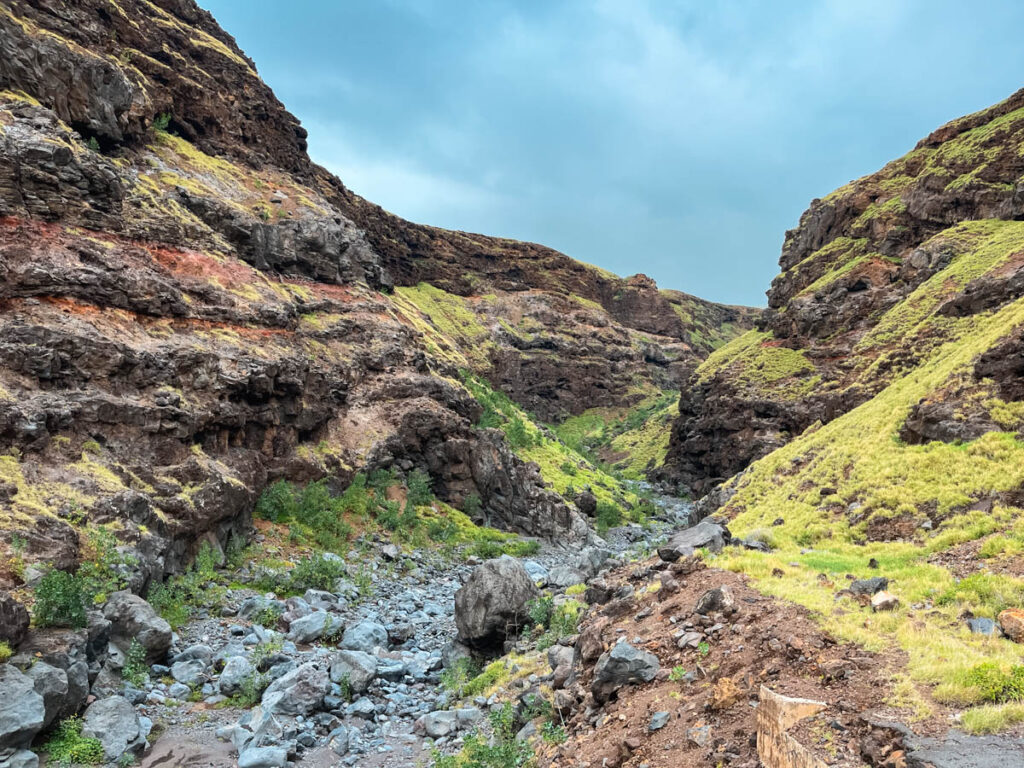
Are there any notable attractions or sights exclusive to the Reverse Road to Hana?
Yes, the Reverse Road to Hana features its own set of attractions and sights that are worth exploring. Some highlights include the Ke’anae Peninsula, Alelele Falls, and Charles Lindbergh’s Grave. By taking the reverse route, you’ll have the opportunity to discover lesser-known gems and enjoy a unique perspective on the scenic beauty of Maui’s eastern coast. We loved this part of the drive!
How much time should I allocate for driving the Reverse Road to Hana?
Driving the Reverse Road to Hana can take a full day, and it’s recommended to allocate at least 8 to 10 hours for the journey. This allows for time for stops at various attractions, photo opportunities, and leisurely exploration. It’s important to plan your itinerary and pace yourself accordingly, considering factors such as road conditions, traffic, and the desired level of engagement at each site along the way. If you don’t want such a long day, consider staying along the route.

Is the Road to Hana Worth Driving?
There is so much hype around this drive, that it’s worth stepping back and deciding whether it’s worth doing. In general we think the Road to Hana is a great driving route, although we visited during a weekday in April during one of the less crowded times of the year. I imagine that the road can get slower and even more crowded. If you have 5 days or more on Maui, we think this is route is a great choice, but if you have less time or want to spend more time visiting beaches, we recommend skipping the Road to Hana. Another shorter route to consider is the West Maui Loop Drive.

Summary of the Reverse Road to Hana
In our opinion, driving the Road to Hana in reverse is the best way to see the sites and do this drive. There are many incredible sites and if you take your time and choose your attractions carefully, you will have an incredible day!
Looking for other Things to do on Maui? Check out:
- 15 Amazing and Adventurous Things to do in West Maui
- How to Drive the West Maui Loop Drive: An Incredible Hawaiian Day Trip
- A Complete Guide to Hiking Haleakala National Park
Pin it
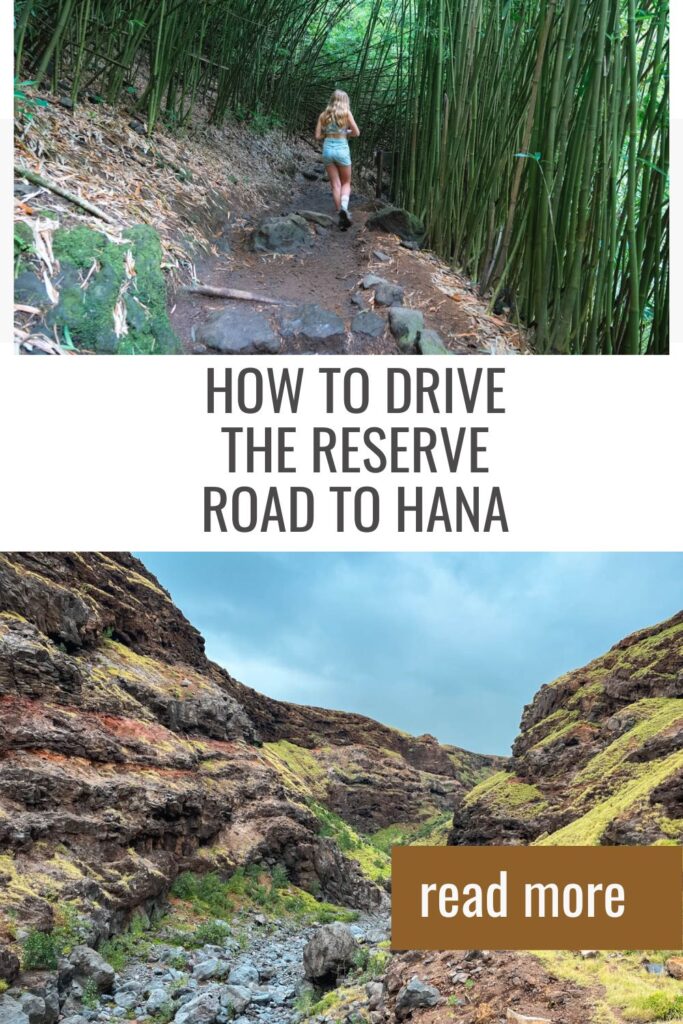



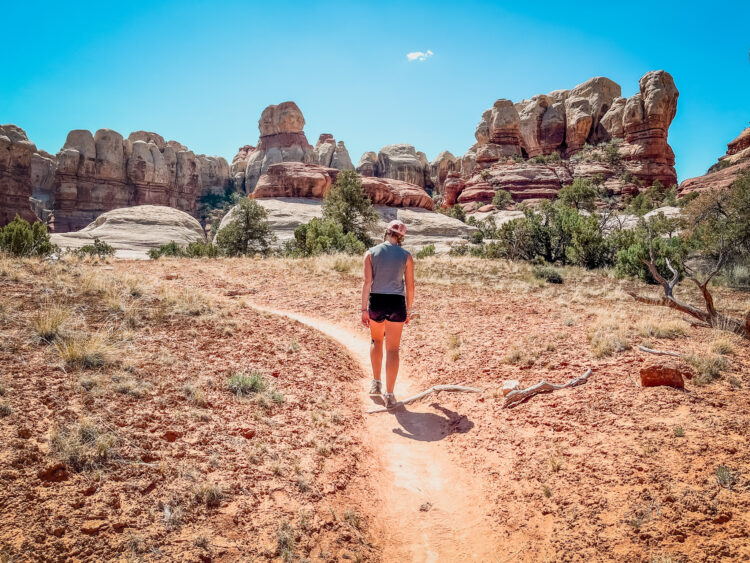
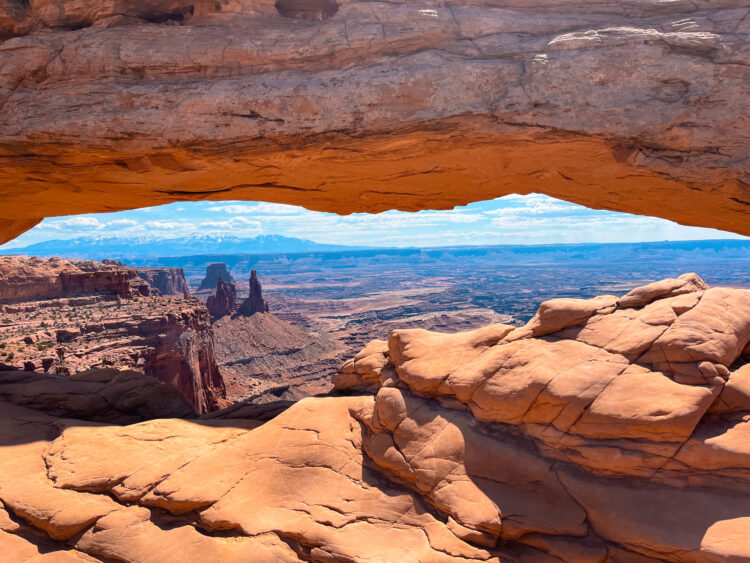

Stunning views! Thanks for sharing this guide. Saving this for future hikes!
Wow what an island and what views! I wish I could travel there 😍
I’ve done the Road to Hana but never the reverse! These are great tips and a perfect map with all the stops along the way! Thank you!!!
You sold me in driving the reverse road. I like the idea of less traffic even if the drive is a bit more challenging. I also like that there are so many options of things to see (with less people).
I wish I have this on hand when we visited Maui and drove to Hana. This is a very helpful guide. 😊
I’ve never thought about reversing the route! It’s great that you get to see additional attractions with fewer crowds this way! Thanks for sharing 🙂
This is the route we took too and absolutely loved it! Ah I miss Maui!